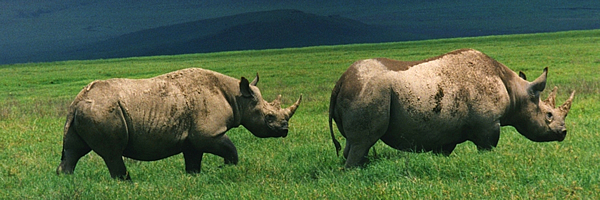Ngorongoro Conservation Area

The Ngorongoro Crater is one of the great natural features of the globe, and one of the jewels in the crown of African wildlife destinations. The Ngorongoro Conservation Area itself is much larger than just the Crater, and includes the north bank of Lake Eyasi and the southern boundary of the Serengeti Plains. It is a designated UNESCO World Heritage Site and a biosphere reserve in every respect deserving of its fame.
The crater itself is perhaps the most recognizable icon of African wildlife conservation, and is the worlds largest, flooded and unbroken caldera, within which is an Eden like valley rich in almost every major species of African plains wildlife. The area of the caldera is only 102 sq miles, but it forms a natural enclosure, and with no human threat directed at any animal within it, there is an air of nonchalance that characterizes the wildlife that itself lends the feeling that one is within and part of the community.
Ringing the crater are the various campsites and lodges that make up the diversity of local accommodation options. These range from the luxurious Sopa Lodge to the Âsling down you swag sites that allow you a ring-side seat to watch the hyena drift up from the crater at night to sniff your camp site.
Ngorongoro is a teaser for the Serengeti. As you ply your way north from Arusha into the Serengeti it is a perfect place to pause and get a feel for what lies ahead. The crater is also a natural photographic studio with several thousand willing subjects all within easy reach of one another. This definitely is a Garden of Eden, and does justice to everyoneÂs favorite mental picture of Africa.
Included also in the Ngorongoro Conservation Area is the Olduvai Gorge site, an archeological site where early Australopithecine remains were found to confirm the Rift Valley as the cradle of humankind, and Laetoli site that showcases early hominoid footprints dating back 3.5 million years.
FAQ
The Ngorongoro Conservation Area is not a national park in the strict sense of the word, and is managed by the Ngorongoro Conservation Area Authority. It was set up in the late 1950s in response to complaints by the Maasai that they were being pushed out of their traditional lands by the creation of the Serengeti National Park. The concept of the reserve is one of eco-tourism, namely that local people intent on pursuing their traditional styles of living can live in close and harmonious commerce with wildlife and in the half century that the experiment has been underway it appears to have succeeded.
The wildlife population of the reserve totals some 25 000 large mammals, mainly ungulates such as wildebeest, zebra, buffalo, Hartebeest, waterbuck, eland and ThomsonÂs gazelle, but also black rhinoceros, elephants and hippopotamus. There is also reputed to be the highest concentration of mammalian predators in Africa, including lion and leopard and cheetah.
Entry Fees
Entry Permit
Above 16yrs  US$50 5-16yrs  US$10 Below 5yrs – free
Foreign Registered Motor Vehicle Entry
Up to 2000kg  US$40 Between 2001-3000kg  US$150 Between 3001-7000kg  US$200 Between-7001-10000  US$300
Tanzanian or East African Registered Vehicle Entry
Up to 2000kg  T.Shs 10 000 Between 2001-3000kg  T.Shs 25 000 Between 3001-7000kg  T.Shs 50 000 Between-7001-10000  T.Shs 100 000
Camping Fees
Established Campsites
Above the age of 16yrs  US$30 Between 5-16yrs  US$10 Below 5yrs  free
Special Campsites
Above the age of 16yrs  US$50 Between 5-16yrs  US$20 Below 5yrs  free
US$100 per day professional photographic and filming fees